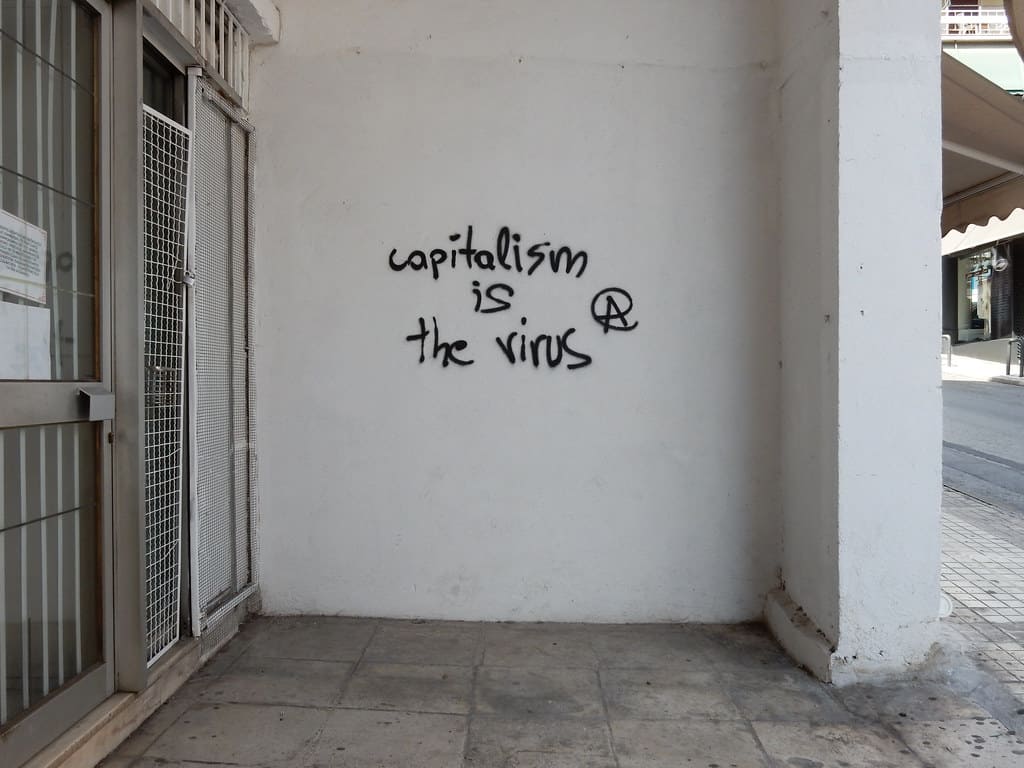Fearing whitewashing by governments, a group of scientists leaked a version of an upcoming IPCC report. The leaked version tells us that capitalism, as we know it, is unsustainable. But what does capitalism have to do with the climate crisis? And if it has to go, what should take its place? How do we “dismantle” capitalism?
This probably flew under your radar, because unlike the official release of the Working Group I Contribution to the IPCC’s Sixth Assessment Report (the one that made headlines for writing “code red for humanity”, remember?) this leak didn’t have a fancy press conference, and the world wasn’t anticipating it. In fact, if not for tweets from climate writers and scientists, I would have missed it too.
According to six “scientist-activists”, from Scientist Rebellion and Extinction Rebellion Spain, the second draft of the Working Group III contribution reveals that the growth model of capitalism is unsustainable. More simply put, as one of the scientists summarises: “Embracing degrowth can be key to managing climate chaos, and capitalism as we understand it is unsustainable.” Now climate science doesn’t tend to be dramatic. In fact, it often errs on the side of caution. Partly because it’s a combined effort of thousands of scientists. Consensus, as we can expect, dilutes strong opinions. Which is to say: for even a draft of an IPCC report to say this? We need to be paying attention.
The leaked version of the report isn’t just saying that capitalism can’t go on. It’s specifically also pointing to the issue of unfettered growth, that’s destroying our planet. Remember how the Working Group I contribution last month pointed out that it’s undeniable that “humanity” is the cause of the climate crisis? This is a step further than that—an allegation that it’s the growth model of capitalism that’s causing the climate crisis.
The math doesn’t add up
The basis for this allegation is this: the growth model of capitalism, which translates to an endless search for maximised profits and cut costs, is leading to the earth’s destruction. At one level, the explanation for this is just simple math.
No matter which way you cut it, “sustainable growth”, “green growth”, or “techno-optimistic growth”, the math just doesn’t add up. Capitalism, that’s all about perpetual growth, is incompatible with a finite planet, with finite resources. As leading climate journalist George Monbiot explains, a system based on this endless growth “cannot function without peripheries and externalities. There must always be an extraction zone – from which materials are taken without full payment – and a disposal zone, where costs are dumped in the form of waste and pollution.”
Even way back in 2018, our consumption levels were already operating at 60% over the safe, ecological limit. A team of scientists proved that if we were to continue business-as-usual then, by 2050 we’d have hit three times the safe limit. That year, leading economic anthropologist Jason Hickel even argued that there’s no evidence to support green growth’s hopes. That while we do need all the climate solutions we have, tech or otherwise, the one thing that will really save us is reducing our consumption and production. Which means no more unfettered growth.
The exploitative logic of capitalism extends to people, too
At another level, we must be clear that the growth model of capitalism is destroying the planet because it’s the model that has justified a continued plundering of not just the earth’s finite resources, but also of its marginalised communities and bodies. You might have heard the saying that a rising tide lifts all boats. And you might have heard that as the justification for capitalism and continued growth.
But the truth is that it’s lifting all boats. And we’re not all in the same boat, to begin with. The most marginalised communities are on, sometimes literally, rafts made out of driftwood. The current system operates by endlessly extracting gains from these marginalised bodies. It benefits those at the top, while promising those at the bottom crumbs. It feeds us with the lie that we, along with the global majority, can pull ourselves up by the bootstraps. The truth is that the system is designed in a way that keeps the people at the bottom, at the bottom. Look around us for evidence of that. From the continued exploitation of garment workers, to the precarity of the gig economy and those it supposedly supports, and to those slaving away under major corporations.
The same exploitative, growth-obsessed system of capitalism that’s destroying the planet? Is the same system that’s destroying entire communities, and sacrificing lives. And yet we’re told the lie that growth is good and that it will “trickle-down” and benefit us all. If anything, the global pandemic has exposed this lie once and for all. It’s showed us that we’ve been addicted to growth for growth’s sake, growth for those at the top’s sake. And that capitalism, with its exploitative logic tied to unfettered growth, has to go.
Growth is intrinsic to capitalism, so if the growth model is the problem: capitalism is the problem
The leaked version of the upcoming report points specifically to the growth model of capitalism. But as Juan Bordera, one of the scientist-activists who leaked the draft, rephrased: capitalism, as we know it, that cannot go on either. This is because the growth model of capitalism is what capitalism is about. Growth, unfettered, exploitative, and unequally distributed, is at the heart of the capitalistic system. Monbiot writes that this idea of “perpetual growth” is a “defining element” of capitalism. Without it, capitalism cannot exist. “Capitalism collapses without growth”. This also explains why, all around us, businesses are under pressure to grow quarter on quarter, year on year. Why investors are obsessing over endlessly increasing their returns. Why you can never seem to put your finger on why you don’t feel like it’s ever “enough”.
Capitalism has seeped into every corner of our lives, and it’s taken over not just the planet, but also the people on it. It’s become a way of thinking, a philosophy, an unspoken guiding principle you’re forced to follow. Capitalism is the virus: and it’s high time we addressed it head-on. But how? If capitalism is the problem, the system is the problem. And if you’re like any other human in this late-stage capitalism world, that probably makes you feel overwhelmed. If the system is the problem, how can we, inevitably within the system, seek out alternatives? As Monbiot writes: “you do not have to produce a definitive alternative to say that capitalism is failing. The statement stands in its own right. But it also demands another, and different, effort to develop a new system.” And in that spirit, I turn to the solutions.
Moving away from growth models
Is it possible to move beyond growth models? Researcher, writer and community organiser Alnoor Ladha presents some preliminary answers.
For Ladha, capitalism is about the “imposition of monolithic values”. We all have to consume our way towards realising the “American Dream”, which is now no longer a dream just of America’s, but because of America’s imposition of itself onto the world, a dream of many everywhere. If this is the case, then, he argues, that we need to acknowledge the many ways of being and living outside of this world of consumption, fuelled by globalised supply chains. The answer then is localism. Lifeways connected to our environment, “so we see and understand the impacts of our consumption”. Much of living more localised lifestyles are already underway. And as Ladha points out, “we have on hand ready guides and knowledge in the Indigenous cultures that have survived longest on this planet, and whose way of organizing and being are in greatest harmony with the biosphere.”
What else is there to post-growth thinking? Ladha, like many others before him, proposes that at a national level, this involves ditching the GDP as an indicator of success. Because of this GDP indicator, we’ve come to prioritise profits and financial gain. Not to mention, the indicator fails to account for the negative externalities of this system, and things like “care”—tangible and important, but unaccountable under GDP-like metrics. Making this happen, however, isn’t so easy. Most people associate a move away from growth as a bad thing. As losing out, and missing out. So a key question, as the scientist-activists ask: is how can that shift be “understood as a benefit and not merely relinquishment?”
Other key questions include figuring out how to account for historic differences in emissions between countries, and the growing inequalities. But renouncing growth as the one and only goal, at any cost, is a start.
Living and birthing anti-capitalist worlds inside this one
What we can do isn’t just restricted to imagining alternative futures, and thinking up answers to alternatives to our current ways of doing things. There are anti-capitalist ways of living inside this capitalist world, and the alternatives are already and have already been present.
Erik Olin Wright, author of How to Be an Anticapitalist in the Twenty-First Century, details the existence of the “social and solidarity economy”. This is an umbrella term “covering a range of economic activities and organizations that are anchored in communities, embody egalitarian and solidaristic values, and are committed to some kind of needs-oriented or social justice mission.” These are projects that sometimes arise out of necessity and survival through crises. Think community kitchens, free clinics, community gardens, caregiving exchanges. But they can also arise from a desire for something different from what we know (capitalism). In this regard, such projects include eldercare and disability care services, affordable housing projects, maker-spaces and cooperatives. These create spaces—Wright calls “emancipatory enclaves within capitalism”—for people to “live very different kinds of lives”.
These are prefigurative projects: projects that strive to reflect the future society in the present. Participating in them doesn’t solve all the problems. And in fact, these projects sometimes can present new problems, contradictions, and tensions. And us participating in them doesn’t mean that we aren’t participating in the capitalistic system. Nor does it mean that we’re temporarily outside of it. Two things can be true at the same time—that we are striving to dismantle capitalism, while operating within it. Purity within a broken system isn’t possible: “We all live by our contradictions.” But through the struggle, we can begin to see what the alternative could look like.
Tackling fossil capitalism
If that still sounds too abstract, then something that’s much more tangible is tackling fossil capitalism, and taking down the fossil fuel industrial complex. We know that the industry is a major player in the destruction of the planet. The fossil fuel industry being tied to the climate crisis isn’t new information. But how is it tied to capitalism?
As Greenpeace explains, the industry, together with governments, used the 2008 financial crisis as an opportunity to perpetuate capitalism. By then, of course, the industry already knew that it would have devastating effects on the planet. That we needed to rapidly decrease emissions. And yet, it continued to cement itself in our lives, and inextricably tie our source of energy, which runs everything that we do, to something that would increase emissions instead. Setting us on a path of destruction. Another way to think about fossil capitalism is this: the way in which the fossil fuel industry profits while exploiting many bodies and the planet, while making us feel like we, and sometimes tangibly, have no other choice—is exactly what capitalism does.
The fossil fuel industry operates on the logic of capitalism and is probably the most powerful example we have of that logic. That the official IPCC report pointed its fingers at “humanity” and not at fossil capitalism is worrying, as some have pointed out. It’s, unfortunately, added to the continued lies that the fossil fuel industry pays the media to tell. So to tackle fossil capitalism, what we need to do is start telling the truth about fossil fuels. To stop the greenwashing, and start revealing how this industry cannot be part of the change. To that end, there are many things individuals can do. Participate in campaigns against corporations, in campaigns attempting to improve legislation, or even just joining organising groups and telling the truth to communities around us.
As climate journalist Emily Atkin says: “What can I do? Anything.”
Taking collective action
Many have written plans to dismantle capitalism. Most of these plans share one thing in common, and that’s the need to take collective action. The Red Nation’s The Red Deal: Indigenous Action to Save Our Earth, highlights that we’ve witnessed “massive grassroots rebellions against the fossil fuel industry, police violence, racist immigration policies, and labor exploitation, yet nothing has coalesced into a unified mass movement.” So, they write, we need to struggle for “non-reformist reforms”, which will help us build this mass movement fast, to “take on the bosses”.
Yet between where we are now and collective action, stand various challenges. Erik Olin Wright outlines a few. The first is the challenge of overcoming our privatised lives. “The tasks of daily life… take enormous amounts of time, energy and attention.” Because of our consumerist society too, we’ve begun to see our private lives and public involvement (or rather community involvement) as separate. We’ve prioritised our own happiness, over the community’s, and envisioned them as sometimes mutually exclusive goals.
Another challenge is the fragmented class structures. As Wright points out, the now-famous “we are the 99%” slogan that was a rallying call back then, has become much less resonant. We’ve come to realise that many people, even within the working class, have different lived experiences. The rise of identity politics further fuels the difficulty of creating a unified struggle, which is why another challenge is competing sources of identity.
How then do we form “effective politically organized collective actors”? To his question, Wright presents some answers. We need, he writes, a discussion of values, which can connect class interests with other identity interests, along with a commitment towards a deeper, real democracy. And on top of all that, we also need to remember that the way forward is a combination of efforts: to resist and escape, and tame and dismantle capitalism. Action on all fronts is what we need, now more than ever.
There is no “blueprint” for dismantling capitalism
In the end, it might seem that there are fewer answers than questions. But it’s in the asking of these questions that we can even begin to approximate the answers.
With the answers that we do have, we can afford a start. We’re not expecting to dismantle capitalism overnight. And some of us don’t even expect to dismantle it within our lifetimes. But what we do know is that we can’t depend, at this point, on incremental changes that don’t acknowledge the deeper root of the problems we see. It’s not just about reducing emissions, or saving an almost-extinct species, or conserving mangroves, alone. Efforts towards saving the planet, as the scientist-activists want us to remember, must recognise and acknowledge the role that capitalism has to play in the current destruction of the planet. When we acknowledge that, we can begin to find our solutions. (Some of which, are really already in our hands, and all around us.)



